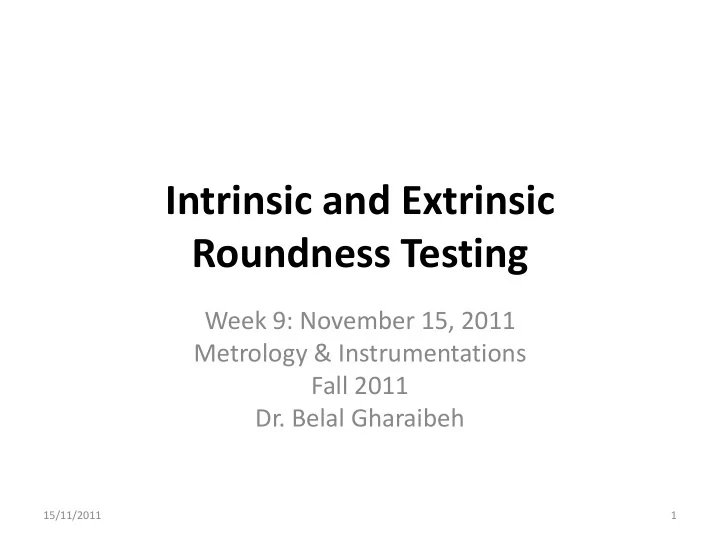

Intrinsic and Extrinsic Roundness Testing Week 9: November 15, 2011 Metrology & Instrumentations Fall 2011 Dr. Belal Gharaibeh 15/11/2011 1
The difference between intrinsic and extrinsic properties • An intrinsic property is an essential or inherent property of a system or of a material itself or within. It is independent of how much of the material is present and is independent of the form the material • A property that is not essential or inherent is called an extrinsic property. • For example, mass is a physical intrinsic property of any physical object, whereas weight is an extrinsic property that varies depending on the strength of the gravitational field in which the respective object is placed, http://en.wikipedia.org/wiki/Intrinsic_and_extrin sic_properties_(philosophy) 15/11/2011 2
1. Diametrical Intrinsic Method • A dial indicator is positioned over the surface to a reference height. • The part is then rolled underneath. • The peak height can then be compared to other readings. 15/11/2011 3
2. Vee Support Intrinsic Method • A dial indicator is positioned over the surface to a reference height. • The part is then rolled underneath. • The peak height can then be compared to other readings. • The Vee support reduces the effect of a single datum point 15/11/2011 4
3. Between Centers • A dial indicator is positioned over the surface to a reference height. • The part is then rotated on centers. • The variations in the readings are then used to evaluate the part. • Location of the center may lead to problems 15/11/2011 5
Intrinsic methods limitations • All three of the intrinsic methods are inexpensive • The Intrinsic methods all have an important limitation. • In particular, if the deformation of the round is small, the methods will deal with it reasonably, • but if the deformation is large enough to make the shape non-cylindrical, then the results will err significantly. Method one limitation: If two readings are taken for the case Reading 2 Reading shown, both readings will indicate 1 roundness, while in reality this is not true 15/11/2011 6
Method 2 limitations This test will give large roundness difference reading due to fact that the part in non-cylindrical 15/11/2011 7
Diameter measurements • When using The Flat Plane, or the Center to intrinsically measure roundness, the diameters can be directly obtained, • but when using the Vee block, some additional calculations are required IR change in center height change in radii A B IR h h A B A B 1 0 sin( ) sin( ) IR A B csc A B IR A B 1 csc 15/11/2011 8
Other disadvantages (Vee block and center support methods) • The vee block method has particular disadvantages: – A number of angles are required (the standard angle is 90°) – only suitable for regular odd lobed figures • The center support method also has Even lobed disadvantages: - The part may be bowed, or warped - off center or degraded center holes will decrease reading quality - the centers themselves can also affect readings Warped shape 15/11/2011 9
Extrinsic Roundness Testing • The features of this methods are, 1. the reference datum is not points on the object, but a separate precision bearing 2. The axis of the part being measured is aligned with the machine bearing axis 3. A stylus is moved in to contact the part, and then it moves about in a circular path 4. The deflection of the stylus is amplified onto a polar plot to be used in evaluation of the part • We can measure the out of roundness value as the minimum distance between two concentric circles that enclose/envelope the trace profile. • This distance must obviously be divided by the magnification. • Only roundness deviations are amplified. This creates distortions in the trace • This method of testing is used for large cylinders and assembled cylinders 15/11/2011 10
Eccentricity • Eccentricity is the deviation of multiple circles from a common center • Concentricity is the opposite word for eccentricity 15/11/2011 11
Output reading of eccentricity test C 15/11/2011 12
Measuring eccentricity • Y: largest deviation between circumferences • X: smallest deviation between circumferences • C: distance between the two circles centers • Magn: the magnification factor 15/11/2011 13
Recommend
More recommend